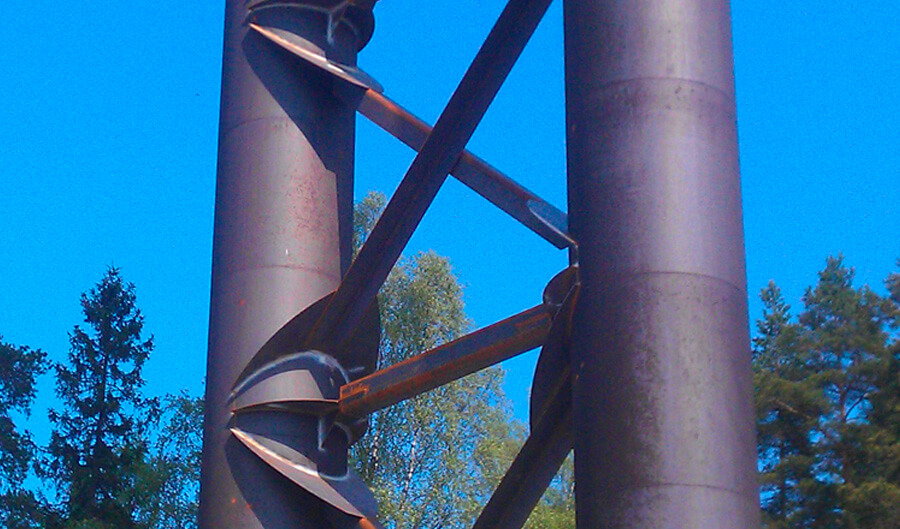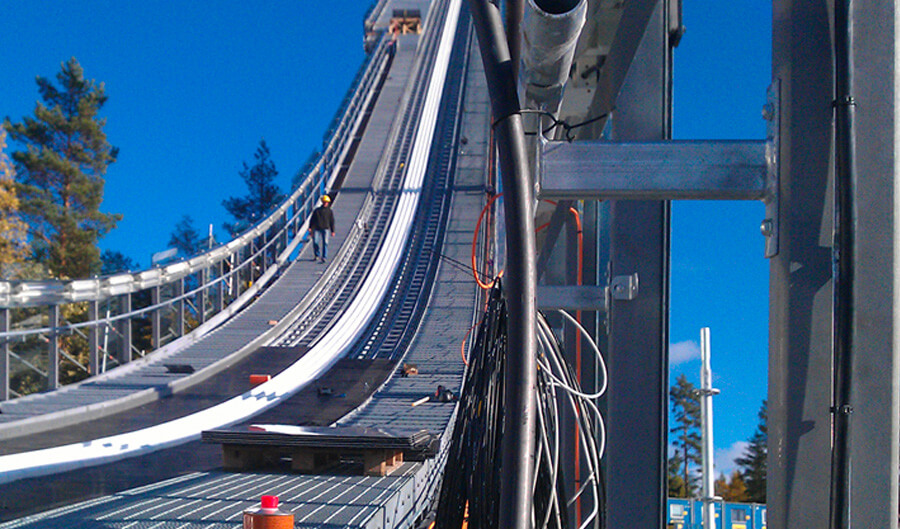Precision welding from top to bottom
The World Ski Championships were held in Falun in 2015, which was the reason for the two new ski jumps. The old jumps were completed for the 1974 World Championships, and were used for the championships again in 1993. A great deal has happened in the sport since then, and the International Ski Federation (FIS) has entirely new standards for championship ski jumps today. The higher of the two jumps is now a K120 (instead of K115), while its smaller companion is a K90, as before.
Everything is new
“All that remains of the old jumps are the supports and side beams,” said Ulrik Jonasson, MD at Sjölins Smide. “Everything else is new – the tower, the inrun and take off, the stairs and handrails, etc. Previously the jumps were a mixture of wood and steel; today it is steel, concrete and glass.”
Sjölins began the job in November, 2012 and finished in January, 2014. They used almost 200 tonnes of steel.
“It was important that the new jumps resemble the old ones as far as possible,” continued Ulrik Jonasson. “The corten steel gave the old jumps a particular rust-red patina, and the new jumps will look similar, too.”

High-level precision construction
Because the new FIS rules mean that all championship jumps must have the same slope, profile and take off, the inrun on the upper jump has been raised while the lower jump is now longer, shallower and the take-off height has been changed. Achieving the exact profile placed great demands on precision measurement, which was a challenge in itself.
“We began by measuring the jump one spring morning in March,” Ulrik Jonasson told us. “When we began work again after break nothing held true. The sun had heated the structure and moved the measuring points several centimetres. How crazy would it be with fifteen below at night, and plus fifteen during the day? We were forced to decide which readings we would work to, and stick to them no matter what.”

While a lot of work was prefabricated at Sjölins Smides’ workshops, a large amount of welding work was also done on site. To enable installation of the new structures onto what remained of the old jumps, Sjölins welded attachment points for bolted joints with 5 mm tolerances.
“Right at the top of the jumps in the towers the welding was not much different from what we’re used to,” said Ulrik Jonasson. “But the actual jumps slope a lot, so it was tricky work safety-wise and from an ergonomic standpoint. After all, we were sometimes working more than 50 metres above ground.”
Elga and Miller
Sjölins used Elga P 48K electrodes, Elgacore cored wires and Miller XMT 350 welders with feeder suitcases. They performed butt welds and fillet welds in all sorts of positions with 5-20 mm root depths and material thicknesses from 10 to 40 mm. Most was in corten steel, but some was also construction steel. Some areas were covered for MAG welding on site on the jump.
“There’s always low-price materials, but we wanted to be absolutely sure of what we were using and enjoy full back-up all the way,” said Ulf. “For example, Elga helped us with the correct welding parameters, WPSs and welding plans for this particular job. It’s more important to be able to weld efficiently and avoid doing work again than saving pennies on a pack of electrodes.”
Approved by FIS
Our working method was verified by a third-party inspector and Lugnet’s own inspector. When FIS performed the final inspection, it declared that the ski line was according to regulations and within set tolerances.
From horse shoes to steel structures
When Per Sjölin began his farriery and smithy in Hudiksvall back in 1883, he would surely not recognise today’s company. He made the last horse shoe in the 1950s, and today Sjölins’ 75 employees work on structural frame contracts nationwide. It makes steel and stainless steel forgings at its own workshop.
FIS Nordic World Ski Championships
The world championships in Falun began February 18, 2015 and covered cross-country, ski jumping and Nordic combined. In addition to the ski jumps, the National Arena at Lugnet also has cross-country tracks, indoor swimming and arenas for many different sports. The tower for the larger ski jump is open to the public, and is the highest viewpoint in Dalecarlia.
